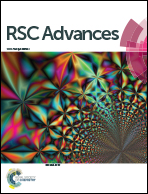Narrow band resonance in the UV light region of a plasmonic nanotextured surface used as a refractive index sensor†
Abstract
We have fabricated two types of plasmonic nanotextured devices (PNDs) using natural lithography technology, which have been applied experimentally in sensing volatile organic solutions (VOS). The PNDs were composed of the hybrid of metal/dielectric structures (PND-1) and metal/dielectric/semiconductor structures (PND-2). They were integrated with microfluidic chips and compared with and without injecting various types of solutions, i.e. DI water, ethanol (C2H5OH), isopropanol (C3H7OH), and ethanediol (C2H4(OH)2). Plasmonic coupling and energy confinement in the PNDs induced a noticeably resonance narrowing of the spectral reflection in the ultra-violet (UV) light region, in which the FWHM (Full-Width at Half-Maximum) was around 20 nm. The experimental results indicate that the sensitivities of the devices are 38.6 nm RIU−1 and 70.8 nm RIU−1 for PND-1 and PND-2, respectively, of which PND-2 is enhanced 1.8-fold compared to PND-1. This sensing approach with high portability, applicability, and cost-effectiveness using plasmonic nanotextured surface based devices may minimize the limitations of time and space in environmental monitoring, food safety and other fields.



 Please wait while we load your content...
Please wait while we load your content...